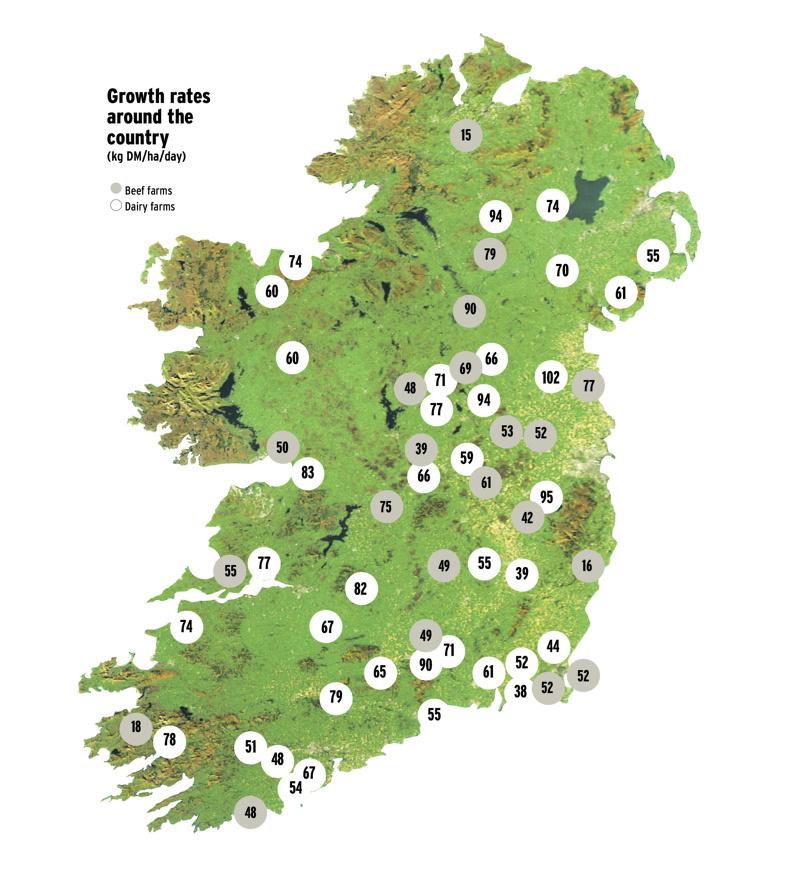Grass growth was back to 53kg DM/ha/day on our measuring beef farms this week. This represents a 17% drop on last week.
However, as always, there is big variation within the data. Some farms are up in the 90s while some of our farmers struggled to hit 20kg DM/ha/day this week.
There may be a number of reasons for this.
A lot of our measuring farms took silage before last week’s wet spell and this ground will have been slow to come back.
Many have also taken the foot off the gas temporarily in terms of fertiliser.
Some farmers on dry ground in the east, particularly areas like Wicklow, got very little of the rain that came last week and the lack of moisture has slowed things down.
In truth, a grass growth figure of 53kg DM/ha/day is still leading to a surplus on the majority of beef farms – ie daily production of grass is exceeding demand.
What’s my demand?
As I highlighted a number of weeks ago, in grass terms the year is starting now. If one of your resolutions for 2018 is to drive on grassland on your farm, you must be proactive soon.
July and August are important months in the grassland calendar, during which we try and build a supply of grass that’ll carry us into the back end and allow us to have a bank ready for early next spring.
Calculating your daily grass demand is the first step to managing your grass. Allow 18kg of daily grass demand per livestock unit (suckler cow and calf = 1.1 LU, weanling = 0.6 LU, yearling = 0.7 LU, two-year-old or greater = 1 LU) and divide your total demand by the number of hectares the group is running to get a daily demand per hectare.
Days ahead
Divide this into your average farm cover (kg DM/ha) to work out a days ahead figure.
At this point of the year, you should be aiming to have around 16 days’ worth of grass on the farm at this point, rising to 30 in mid-September.


Co Meath
System suckler to bull beef
Soil type heavy clay
Avg farm cover (kg DM/ha) 934
Grass demand (kg DM/ha/day) 32
Growth (kg DM/ha/day) 69
Grass is in good supply on the farm. Growth rates have remained strong in recent weeks and with silage ground coming back on the grazing platform, this should allow me to take out a few more surplus bales before I start building covers for the autumn.
AI is currently taking place on farm and thankfully it is going very well.
To date, I have around 80 cows served and will continue with AI for another while yet before the Limousin stock bull is let out to finish off.
All calves got their first worm dose last week and they also received their first shot of Tribovax 10 to protect them against clostridial disease.
They will get their booster shot in four weeks’ time. I slaughtered the first of my U-16 month bulls last week. These were on ad-lib meal for the last 100 days I was very pleased with their kill-out and they all reached the required fat cover.
Earlier this week, I divided a 25-acre silage field to allow me to better manage the grass during the shoulders of the year when it is been grazed.

Co Cork
System suckler/calf to bull beef
Soil type relatively dry
Avg farm cover (kg DM/ha) 1,227
Grass demand (kg DM/ha/day) 46
Growth (kg DM/ha/day) 63
I am planning to take out my second-cut silage in the next week or two, weather permitting. I take all my silage as bales and aim for quality always.
I plan to spread one bag per acre of 18-6-12 with sulphur on all ground once silage is taken off. Dairy-bred calves are eating 1kg of ration per day at grass.
I have 96 calves at grass this year and will sell some in the autumn as weanlings, with the rest taken on to finish.
I weighed all stock recently. My cows averaged 650kg, with the lightest first-calvers averaging 480kg. My calves are weighing 200-300kg at the moment.
I will calculate my cow efficiency (percentage of cow weight weaned) once I get my calf weight at weaning. Dosing was carried out on all calves for worms recently.
I will dose again if required in early autumn.
My store cattle are to continue at grass until late autumn when I will introduce ration with a view of finishing before Christmas.

Co Laois
System suckler/calf to beef
Soil type mostly dry
Avg farm cover (kg DM/ha) 1,290
Grass demand (kg DM/ha/day): 61
Growth (kg DM/ha/day): 48
One or two very strong paddocks are bringing up my average farm cover but I’ve some really nice after-grass coming back into the rotation for my heifers and bulls which I hope to finish later in the year.
I weighed the heifers earlier this week and I was a bit disappointed considering they only achieved 0.9kg/head/day since early April. I hope to really push these on now by letting them into nice covers and not forcing them to clean it out like I have all season.
I’ll weigh the bulls later in the week and hopefully they’ll be over 475kg as I usually put them to the shed in mid-August with a view to having them gone before Christmas.
The dairy-cross calves gave me a pleasant surprise weighing in at 152kg on average.
I’ve decided to continue feeding 1kg of meal as I want to keep them for breeding, bringing more milk into the herd. I feel it’ll be a challenge to calve them down at 24 months.

Derrypatrick Herd
System suckler to beef
Soil type mixed
Average farm cover (kg DM/ha) 613
Grass demand (kg DM/ha/day) 55
Growth (kg DM/ha/day) 55
Second-cut silage was harvested on 18 July in excellent weather conditions, following a seven-week growing period, and should provide suitable forage for suckler cows over the indoor winter period.
The decision was made to harvest during good weather rather than wait an extra week to enhance yield.
Despite this, we achieved a yield of4tDM/ha following the application of slurry (3,000 gallons/acre) and CAN (three bags/acre) after the first-cut was harvested.
Grass growth exceeded our expectation following the harvest of our second-cut silage and required us to remove additional surplus grass this week.
Ensuring pre-grazing covers stay on target (1,200-1,400kg DM/ha) requires surplus grass to be removed and this has positive benefits on grass production, quality of grazed grass and animal performance.
We are currently incorporating clover into half of the farm in preparation for a clover trial.

Read More
Grass plus: Dairy
Grass growth was back to 53kg DM/ha/day on our measuring beef farms this week. This represents a 17% drop on last week.
However, as always, there is big variation within the data. Some farms are up in the 90s while some of our farmers struggled to hit 20kg DM/ha/day this week.
There may be a number of reasons for this.
A lot of our measuring farms took silage before last week’s wet spell and this ground will have been slow to come back.
Many have also taken the foot off the gas temporarily in terms of fertiliser.
Some farmers on dry ground in the east, particularly areas like Wicklow, got very little of the rain that came last week and the lack of moisture has slowed things down.
In truth, a grass growth figure of 53kg DM/ha/day is still leading to a surplus on the majority of beef farms – ie daily production of grass is exceeding demand.
What’s my demand?
As I highlighted a number of weeks ago, in grass terms the year is starting now. If one of your resolutions for 2018 is to drive on grassland on your farm, you must be proactive soon.
July and August are important months in the grassland calendar, during which we try and build a supply of grass that’ll carry us into the back end and allow us to have a bank ready for early next spring.
Calculating your daily grass demand is the first step to managing your grass. Allow 18kg of daily grass demand per livestock unit (suckler cow and calf = 1.1 LU, weanling = 0.6 LU, yearling = 0.7 LU, two-year-old or greater = 1 LU) and divide your total demand by the number of hectares the group is running to get a daily demand per hectare.
Days ahead
Divide this into your average farm cover (kg DM/ha) to work out a days ahead figure.
At this point of the year, you should be aiming to have around 16 days’ worth of grass on the farm at this point, rising to 30 in mid-September.


Co Meath
System suckler to bull beef
Soil type heavy clay
Avg farm cover (kg DM/ha) 934
Grass demand (kg DM/ha/day) 32
Growth (kg DM/ha/day) 69
Grass is in good supply on the farm. Growth rates have remained strong in recent weeks and with silage ground coming back on the grazing platform, this should allow me to take out a few more surplus bales before I start building covers for the autumn.
AI is currently taking place on farm and thankfully it is going very well.
To date, I have around 80 cows served and will continue with AI for another while yet before the Limousin stock bull is let out to finish off.
All calves got their first worm dose last week and they also received their first shot of Tribovax 10 to protect them against clostridial disease.
They will get their booster shot in four weeks’ time. I slaughtered the first of my U-16 month bulls last week. These were on ad-lib meal for the last 100 days I was very pleased with their kill-out and they all reached the required fat cover.
Earlier this week, I divided a 25-acre silage field to allow me to better manage the grass during the shoulders of the year when it is been grazed.

Co Cork
System suckler/calf to bull beef
Soil type relatively dry
Avg farm cover (kg DM/ha) 1,227
Grass demand (kg DM/ha/day) 46
Growth (kg DM/ha/day) 63
I am planning to take out my second-cut silage in the next week or two, weather permitting. I take all my silage as bales and aim for quality always.
I plan to spread one bag per acre of 18-6-12 with sulphur on all ground once silage is taken off. Dairy-bred calves are eating 1kg of ration per day at grass.
I have 96 calves at grass this year and will sell some in the autumn as weanlings, with the rest taken on to finish.
I weighed all stock recently. My cows averaged 650kg, with the lightest first-calvers averaging 480kg. My calves are weighing 200-300kg at the moment.
I will calculate my cow efficiency (percentage of cow weight weaned) once I get my calf weight at weaning. Dosing was carried out on all calves for worms recently.
I will dose again if required in early autumn.
My store cattle are to continue at grass until late autumn when I will introduce ration with a view of finishing before Christmas.

Co Laois
System suckler/calf to beef
Soil type mostly dry
Avg farm cover (kg DM/ha) 1,290
Grass demand (kg DM/ha/day): 61
Growth (kg DM/ha/day): 48
One or two very strong paddocks are bringing up my average farm cover but I’ve some really nice after-grass coming back into the rotation for my heifers and bulls which I hope to finish later in the year.
I weighed the heifers earlier this week and I was a bit disappointed considering they only achieved 0.9kg/head/day since early April. I hope to really push these on now by letting them into nice covers and not forcing them to clean it out like I have all season.
I’ll weigh the bulls later in the week and hopefully they’ll be over 475kg as I usually put them to the shed in mid-August with a view to having them gone before Christmas.
The dairy-cross calves gave me a pleasant surprise weighing in at 152kg on average.
I’ve decided to continue feeding 1kg of meal as I want to keep them for breeding, bringing more milk into the herd. I feel it’ll be a challenge to calve them down at 24 months.

Derrypatrick Herd
System suckler to beef
Soil type mixed
Average farm cover (kg DM/ha) 613
Grass demand (kg DM/ha/day) 55
Growth (kg DM/ha/day) 55
Second-cut silage was harvested on 18 July in excellent weather conditions, following a seven-week growing period, and should provide suitable forage for suckler cows over the indoor winter period.
The decision was made to harvest during good weather rather than wait an extra week to enhance yield.
Despite this, we achieved a yield of4tDM/ha following the application of slurry (3,000 gallons/acre) and CAN (three bags/acre) after the first-cut was harvested.
Grass growth exceeded our expectation following the harvest of our second-cut silage and required us to remove additional surplus grass this week.
Ensuring pre-grazing covers stay on target (1,200-1,400kg DM/ha) requires surplus grass to be removed and this has positive benefits on grass production, quality of grazed grass and animal performance.
We are currently incorporating clover into half of the farm in preparation for a clover trial.

Read More
Grass plus: Dairy












 This is a subscriber-only article
This is a subscriber-only article











SHARING OPTIONS: